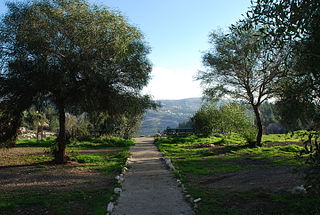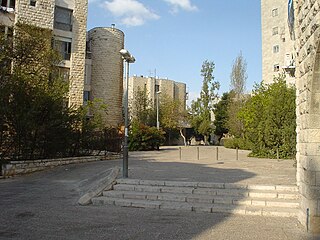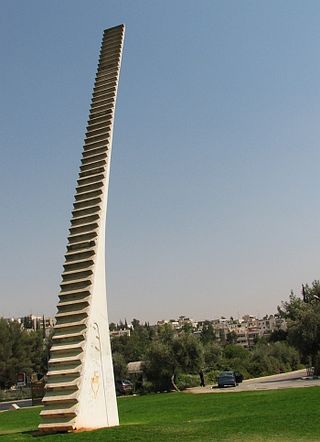
Mercaz HaRav is a national-religious yeshiva in Jerusalem, founded in 1924 by Ashkenazi Chief Rabbi Abraham Isaac Kook. Located in the city's Kiryat Moshe neighborhood, it has become the most prominent religious-Zionist yeshiva in the world and synonymous with Rabbi Kook's teachings. Many Religious Zionist educators and leaders have studied at Mercaz HaRav, where hundreds of future militants, opposed to territorial compromises and promoting Israeli settlement of the occupied Palestinian territories, received their formative education.

Beit HaKerem is a largely secular upscale neighborhood in southwest Jerusalem. It is located between Kiryat Moshe to the northwest and Bayit VeGan to the south. Beit HaKerem has a population of 15,000.

Kiryat HaYovel is a neighborhood in southwestern Jerusalem on Mount Herzl. It was built in the early 1950s to house new immigrants. Today, Kiryat HaYovel has a population of 25,000 residents.

Ramat Eshkol is an Israeli settlement and neighborhood in East Jerusalem. It was built on land captured from Jordan in the Six-Day War and was the first neighborhood built in East Jerusalem after the Six-Day War in 1967. The international community considers Israeli settlements in East Jerusalem illegal under international law, but the Israeli government disputes this.

The Ohel Yitzchak Synagogue also known as the Shomrei ha-Chomos Synagogue and the Ungarin Shul is located in the Muslim Quarter of the Old City of Jerusalem. It was built as a yeshiva in the 1870s by Kolel Shomrei HaChomos, an organization of Hungarian Jews, but was abandoned after the riots of 1938. Although the building was destroyed after 1948, it has recently been acquired by a Religious Zionist group for refurbishment and was reopened after restoration work finished in October 2008.

Hardal usually refers to the portion of the Religious Zionist Jewish community in Israel which inclines significantly toward Haredi ideology.

The Malha Arena is a multi-purpose indoor arena that is located in Jerusalem's Malha neighborhood, across from Ramat Denya and Ramat Sharett. The arena is primarily used to host basketball, futsal, and handball games, and gymnastics.

Ramat Shlomo is an Israeli settlement in East Jerusalem. The population, mostly ultra-Orthodox, is 20,000.

Shlomo Hillel was an Iraqi-born Israeli diplomat and politician who served as Speaker of the Knesset, Minister of Police, Minister of Internal Affairs, and ambassador to several countries in Africa. As an agent of the Mossad LeAliyah Bet in the late 1940s and early 1950s, he arranged the mass airlift of Iraqi Jews to Israel known as Operation Ezra and Nehemiah.

Arnona is an upscale neighborhood in southern Jerusalem, situated between the neighborhood of Talpiot and kibbutz Ramat Rachel.

Kiryat Menachem is a neighborhood in southwest Jerusalem. It is bordered by Ir Ganim to the south and east, Mount Ora to the west, and the Jerusalem hills to the north. To the west are steep hills that descend toward streams that flow into Nahal Sorek to the north of Hadassah Ein Karem Hospital. The neighborhood overlooks the village of Ein Karem, Nahal Sorek, and the ruins of Sataf.

The Bukharan Quarter, also HaBukharim Quarter or Bukharim Quarter, is a neighborhood in the center of Jerusalem, Israel. The neighborhood was established by Bukharan Jews of the Old Yishuv. The neighborhood also anchored communities from modern-day Afghanistan and the Iranian city of Meshad. It belonged to the early Jewish neighborhoods built outside the Old City of Jerusalem as part of a process which began in the 1850s. Today most of the residents are Haredi Jews.

Ramat Sharett is a neighbourhood in southwest Jerusalem, located between Ramat Denya and Beit VeGan. The neighborhood was established in 1974 and named for Moshe Sharett, Prime Minister of Israel in 1953-1955.

Arzei Habira is a Haredi neighborhood in Jerusalem. It is bordered by Ma'alot Dafna to the north, Shmuel HaNavi to the west, Beit Yisrael to the south, and Road 1 and Sheikh Jarrah to the east.
Neve Granot is a neighborhood in Jerusalem located behind the Israel Museum, overlooking the Monastery of the Cross.

Ma'alot Dafna is an Israeli settlement and a neighborhood in East Jerusalem. It borders the neighborhood of Shmuel HaNavi to the west, Ammunition Hill to the east, Ramat Eshkol to the north and Arzei HaBira to the south.

Ramat Beit HaKerem is a Jewish neighborhood in Jerusalem. It was established in 1991 on a hill between Beit HaKerem to the north, the Givat Ram campus of the Hebrew University to the east, and Bayit VeGan to the southwest.

Givat Beit HaKerem is a Jewish neighborhood in Jerusalem. It is located in the west part of Jerusalem.


















